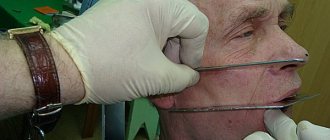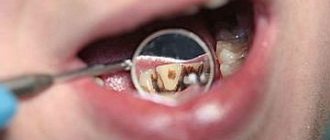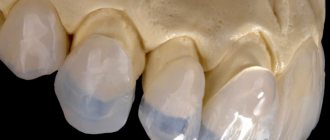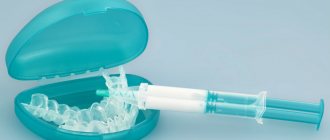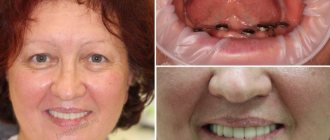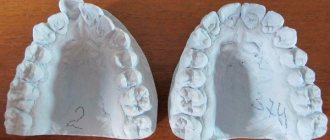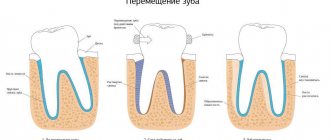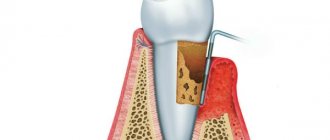Natural color is milky white, slightly translucent. If the teeth are snow-white, the dentist has intervened; such tones are not present from birth. The shade depends on dentin and enamel. In a person's youth, the enamel layer is stronger. The dentition looks whiter if the enamel layer is dense and does not allow light to pass through. This is achieved by removing irregularities.
With age, teeth wear down, the surface becomes smoother, light passes through more easily, which makes the image dimmer. The enamel becomes brown, yellow, black or gray. Different parts of the structure have different colors. A light shade predominates on top, a dark shade on the bottom. But each person has his own natural tone - this is normal.
Author of the article: Shirokov Ivan Yurievich
Work experience:
15 years
Specialization:
Dentist-orthopedist
Works:
at the clinic on Butyrskaya metro station
What color is considered normal for a milk bite?
Baby or primary teeth in children are usually whiter than permanent teeth in adults. This color comes from thinner enamel than permanent crowns. If the milk crowns have a yellowish or grayish tint, then this indicates their disease or a metabolic disorder in the body.
The method of returning the natural shade to temporary units depends on the reasons for its change. Sometimes it is enough to exclude certain foods from the diet and start filtering the water, and the color of the crowns will gradually be restored. If the change in enamel color is caused by a disease, then it is important to establish a diagnosis and select adequate treatment.
Where to get prosthetics?
Many clinics provide partial or complete prosthetics services. Find doctors based on reviews. Contact a clinic that has proven its professionalism through experience and work.
A doctor who knows his business will not rest until he brings his smile to perfection. The equipment of the clinic is important. Equipment in the hands of an experienced doctor works wonders. You will get what you expected.
As for the price, it depends on the case. Prices range from 1,700 rubles for simple crowns to 30,000 for lumineers or veneers. The procedure will cost 21,000 apiece.
Reasons for changes in enamel color in children
- Some diseases of a pregnant woman: viral or bacterial infections of the mother’s body, as well as some medications (for example, tetracycline antibiotics) leave an imprint on the development of the fetus, including the formation of its tooth buds. This is fraught with the fact that the baby will erupt in units already with a defect (enamel hypoplasia or hyperplasia, tetracycline teeth, etc.),
- initial stage of caries: may change the color of milk crowns (white spots appear on them),
- fluorosis: a surplus of fluoride in a child’s body (due to the large consumption of fluoride-containing products, water, the use of toothpaste with a high content of this element) changes the color of the enamel, it becomes grayer and at the same time rough, brittle, with grooves,
- treatment with iron preparations: if they are used in liquid form, they cause temporary darkening of the tooth surface,
- constant consumption of coloring products: blueberries, bird cherry, sweets and drinks with artificial colors or based on red and blue berries.
What to do if your tooth color has changed
If a tooth suddenly darkens or acquires an uncharacteristic shade, it is probably due to pathological processes that require immediate help from specialists. You cannot delay with such a symptom - you need to contact a dentist as soon as possible so that he can assess the degree of deviation from the norm and diagnose the cause of the pathological phenomenon. A tooth can suddenly darken as a result of injury, the development of necrotic processes in the pulp area, or due to the presence of filling material containing silver, tin, mercury or zinc (obsolete materials).
Changes in enamel color indicate some pathological processes
If we talk about changing the color of the entire smile at once, then among the common prerequisites for the problem are work in the metallurgical industry, excessive consumption of coffee, strong tea, coloring products, smoking, taking powerful medications, and low levels of hygiene. In any case, such a situation requires increased attention and mandatory examination by a specialist. Even if it's all about poor hygiene or excessive coffee consumption, it's imperative to have a hygienic cleaning at the dentist's office. Otherwise, plaque will soon turn into hard deposits and become a prerequisite for the development of carious processes.
Reasons for changes in tooth shade in adults
- violation of the rules of brushing teeth at home: irregularity, unsuitable toothpaste or brush,
- hereditary reasons
- the richness of the daily menu with pigmented products: black berries, strong black and red tea, coffee without milk, red wine, ketchup, soy sauce, etc.,
- smoking: gives a yellow or even gray-yellow coating,
- With age, dentin darkens and enamel becomes thinner: therefore, crowns acquire a darker shade than in youth - due to translucent dentin. Thinning of the enamel due to metabolic disorders also leads to a change in the color of the unit, because dentin is naturally yellow,
- deficiency or surplus of certain vitamins or microelements: zinc, fluorine, iron in the body,
- the presence of an old filling: often its elements penetrate into the dentin over time, oxidize and color it gray or red, which affects the external shade,
- microrelief of the crown surface: the more pronounced it is (grooves, pits, roughness), the darker the crowns appear.
Attention! After professional teeth cleaning (without bleaching), crowns may become a shade or even two lighter. This happens because the hygienist removes plaque, which gives a darker color, grinds and polishes the teeth, leveling the microrelief.
Technique for determining color - how to choose the right shade
So, we found out that the Vita scale is used to determine what color a person’s teeth are and how to choose a shade during dentures or before lightening. But to correctly assess the condition of the enamel, the correct inspection technique is required. Below we will take a closer look at how the tone of teeth is determined and the shade closest to it is selected from the scale.
Preparing for a Smile Appearance Assessment
Before comparing enamel with the Vita palette, the patient must thoroughly clean his teeth of plaque and stone. However, more often than not this is not enough. Therefore, it is necessary to additionally carry out professional cleaning of dental plaque to restore the natural shade.
Before assessing color, you need to have your teeth professionally cleaned.
What factors influence color perception?
To properly assess tone, the inspection must be carried out under certain conditions. Thus, the results may be distorted due to incorrect lighting, poor quality of cleaning the enamel from plaque, the presence of foci of inflammation and other dental problems. Therefore, such diagnostics also require careful and attentive preparation.
Optimal conditions for the procedure
When answering the question of how to calculate how many shades your teeth have changed their color, you need to thoroughly clean them first. At the same time, fluorescent lamps must be installed in the dental office. The patient is advised not to wear bright clothes - it is better to give preference to calm pastel colors that will not create a sharp contrast.
The inspection must be carried out under certain conditions
Scope of application of the Vita scale
Using a basic color chart, the dentist can identify the “native” shade of a person’s teeth or detect, if any, possible color defects. The fact is that the same tooth color looks different in people with different skin colors. For example, an unpleasant yellow tint is masked if a person returns from vacation very tanned, and then his smile appears white. However, the Vita scale helps to adequately assess the clinical picture. Such a tool is important in several dental fields.
The Vita scale is often used in the following situations:
- professional teeth cleaning with ultrasound and Air-flow: after ridding the patient of plaque, the hygienist must make sure that he has restored the natural color of the crowns. In addition, the Vita scale can be used before the procedure to conduct a comparative analysis of the effect of tartar on the color of crowns and to develop an individual oral care program for a particular person (this may include both nutritional correction and the cessation of bad habits, the use of certain brands of dental pastes and even brushes),
- for whitening in the clinic: laser, intracanal, photo bleaching, chemical bleaching. The doctor needs the palette to determine how many shades the enamel needs to be whitened, whether the result will look unnatural and whether it will lead to negative consequences, especially if the patient wants a snow-white smile, but the condition of his crowns does not allow him to achieve such a shade. In addition, during the procedure, the doctor should check the result so as not to overdo it,
- dental restoration: in the presence of chips, cracks and other surface defects, it is important that the filling, crown or microprosthesis are not noticeable on natural dental tissues.
What do natural teeth look like?
Innate color depends on:
- genetic factor;
- human habitat;
- skin color, race.
There is a common belief that black people have a white smile. This is a fallacy, an optical illusion. Their smiles appear brighter against dark skin backgrounds. If you compare the jaws of an African American and a Slav, the result is the same. This phenomenon is found in tanned people. If a person lies in the sun for at least an hour, this is enough to transform his smile.
How is the Vita scale used?
All the previously mentioned reasons must be taken into account by the dentist when a patient comes to him who needs treatment or cosmetic restoration of crowns. In all these cases, the doctor must focus on the natural appearance of the enamel in order to select the filling material of the desired shade or install veneers. For this, doctors use the Vita scale.
It is represented by a kind of palette, divided into quarters (sectors), designated by indices A, B, C and D. Each sector has several subtones, and thus the doctor has the ability to operate with 16 shades. This allows you to correctly correct the color during treatment or prosthetics. In addition, the patient himself can compare and choose the shade that seems most natural and acceptable to him.
Interesting! The Vita scale is usually made of laminated cardboard, plastic or thick paper, but professionals use a movable table with painted acrylic or ceramic overlays. This device is convenient to apply to the teeth, comparing and adjusting shades. The basic table produced by Ivoclar Vivadent (Liechtenstein) has good reviews from doctors all over the world. Its slats include the lightest shades (Bleach) of groups A, B, C and D. This palette costs 1,400 rubles.
In modern dentistry, all possible shades of enamel are usually divided into 4 groups:
- group A: reddish with a brownish bias, includes the five most popular shades - A1, A2, A3, A3.5 and A4,
- group B: red with a yellow bias. Includes 4 semitones from B1 to B4,
- group C: gray shades. This also includes 4 semitones - from C1 to C4,
- group D: red with a gray bias. Less common in our country, it has only three subtones - from D2 to D4, and D1 is absent altogether.
“The Vita scale is easy to use. Reusable, easy to apply due to the fact that it is laminated. I recommend purchasing this product for those who whiten their teeth at home. It will last a very long time."
Nastya, review from otzovik.com
What is the relationship between enamel color and systemic diseases
Poor hygiene and dental diseases are not the only factors leading to darkening of the enamel. So, for example, such a nuisance can occur due to disruptions in fluoride metabolism in the body, with some systemic diseases and heavy metal poisoning. If we talk about dental pathologies, then fluorosis leads to the appearance of dark spots on the teeth, and the pulpless units completely darken from the inside.
Changes in the color of the enamel may indicate serious diseases of the body
If hard tissues have acquired a reddish tint, this may indicate internal disorders, such as rheumatism, porphyria, infectious pathologies: typhoid, cholera, dysentery. The condition of teeth also worsens with diabetes mellitus, as well as other disorders of the endocrine system.
Modern dental clinics offer all possibilities for correcting the shade of enamel: from professional and endodontic whitening to the installation of veneers or crowns. But it is better, of course, to initially maintain oral hygiene, monitor the health of your teeth and gums, and undergo regular preventive examinations with a dentist in order to protect yourself from many dental problems.
- Vavilyuk A A. Teeth whitening: what you need to pay attention to when choosing different systems, 2004.
Tone selection features
To accurately determine which shade of the crown will be as close as possible to the natural color of the patient’s teeth, the doctor conducts a test using the Vita scale (see the visual photo below). According to the Vita determination rules, the dentist first selects which of the 4 groups the patient’s enamel color belongs to, and then within this group begins to select shades that most closely match the color of neighboring units.
How tone is assigned
The Vita subtone number is assigned based on the decrease in whiteness: the higher the number (or index), the darker the enamel color will be. For example, an overlay from the palette marked as A1 is the “whitest”, and A4 is the darkest of group A. And this rule applies to all groups.
2. Why high technology doesn’t always help
You can often read negative comments on forums that computer technology is not used to determine tone. And although there are programs developed specifically for such a procedure, the most accurate is still a visual comparison of the patient’s crowns with the base table.
Interesting to know! An adequate assessment of color by a computer is influenced by many factors: the lighting in which the image loaded into the program was taken, the resolution and color sensitivity of the camera used to take the image, and the color calibration of the computer itself. And even if at some point there was a failure of a tenth of a percent, this may affect the final result, and the sample selected by the computer will turn out to be lighter or darker than necessary.
In addition, using programs to determine the color of crowns is more expensive than using the basic Vita table, which is why doctors most often resort to this method, especially in small dental offices. And it’s more convenient for patients to compare samples in person.
3. What conditions are necessary for high-quality diagnostics
Despite the fact that using the Vita scale is cheaper and gives more accurate results, it is important to observe certain conditions when testing:
- Before testing, you need to brush your teeth twice: once at home, immediately before the appointment, and the second time the doctor cleans it using special solutions. This is necessary in order to remove microplaque that forms daily on the enamel and can affect its color,
- It is recommended that the patient come to the appointment wearing clothes in neutral pastel colors and with an open neck so that the fabric does not contrast with the face and teeth. If a person wears white, black or other bright clothing, this may distort the doctor's perception,
- In the dentist’s office, it is important to create high-quality lighting: if testing takes place in the dark, dentists use powerful lamps or special frames with LEDs to simulate daylight, which are held by the doctor’s assistant or the patient himself during testing. For the accuracy of the procedure, it is important to fully illuminate all crowns,
- the patient must be healthy: the choice of color tone according to the Vita scale, as a rule, is carried out only on healthy units of the dentition and in the absence of any chronic acute diseases in the patient. This is done because any serious disease of organs and systems can affect the natural color of crowns,
- if the patient has teeth with different shades of enamel: here the doctor often recommends an intermediate shade or a decision is made to correct not just one tooth, but the entire smile area.
Preventive measures
If over time your smile has yellowed, your teeth have become dull and stained, in some cases you can do without in-office whitening and veneers. To do this, it is enough to undergo a professional cleaning procedure in the dentist’s office and subsequently provide competent prevention:
- give up bad habits, reduce consumption of coffee, strong tea and coloring products,
- maintain a high level of hygiene, brush at least twice a day, rinse your mouth every time after eating, use floss,
- start treatment of emerging dental problems in a timely manner and undergo preventive examinations at least twice a year.
Using hygiene products will help preserve the color of the enamel.
If the cause of the darkening has more serious justifications, you will need to undergo a full diagnosis in order to identify the true causes of the problem and then work directly with them. Professional whitening, microprosthetics or installation of crowns/prostheses will help correct the aesthetic defect.
How to maintain results for a long time
After dentures or whitening, it is very important to keep the color of your smile natural. To do this, it is important to follow the recommendations for caring for dentures (if artificial crowns or veneers were installed) or directly for the teeth (after the whitening procedure).
As a rule, the main stages of care are daily oral hygiene, exclusion from food (at least for the first weeks) of coloring foods - berries, wine, strong tea or coffee, as well as quitting smoking.
Good to know! Bleached enamel becomes thinner, and therefore more sensitive, so to care for it you need special gentle pastes and brushes with soft bristles. Doctors also advise rinsing your mouth after every meal and using floss for high-quality cleansing.
The same goes for veneers and ceramic inlays. For example, it is not recommended to use electric ultrasonic toothbrushes if you have such microprostheses, since the high frequency of rotation or vibration of the brush head can heat the prosthesis or peel off the adhesive, which leads to deformation of the prosthesis or a reduction in service life.
Do not forget to visit the dentist once every six months so that he can monitor the condition of the oral cavity and dentures, adjust hygiene procedures, and also diagnose the presence of diseases, in particular caries, in a timely manner.
Restoring lost color
If initially the patient’s teeth were much lighter and brighter, but over time they began to darken and lose their natural shade, you can try to do without expensive whitening and restore the color yourself. Typically, the following techniques give a good effect, provided they are used regularly:
- Quitting bad habits and, first of all, smoking.
- Maintain good oral hygiene, including brushing with fluoride-free whitening toothpastes and rinsing.
- Regular visits to the dentist and timely dental treatment.
- At least temporarily avoid drinks and foods with dyes, caffeine and fluoride.
We should not forget about prevention, which is recommended even if the normal color of tooth enamel is preserved. If all the efforts made were in vain and the smile is still far from ideal, you can resort to more radical measures.
As a rule, we are talking about professional services that include dental cleaning with the removal of stones and accumulated plaque, as well as external or intracanal whitening, which is most often carried out using special chemical solutions based on hydrogen peroxide. The latter procedure is indicated primarily for those patients who have suffered periodontitis (traumatic), and its main disadvantage is the increased sensitivity of the teeth.
If you want to make your teeth perfectly white for the long term, then it is better to resort to installing veneers, lumineers or ultraneers. It should be noted that, in addition to aesthetic indications, such manipulations are relevant for patients whose teeth have darkened due to regular use of medications or after the installation of artificial materials (fillings) that caused a change in color.
Determination technique
The accuracy of determining the color of a tooth depends on many factors: the experience of the dentist, the quality of lighting in the office, the material for making the scale, etc. Therefore, before visiting a dental clinic, you need to make sure that a qualified specialist and equipment are available.
Otherwise, the patient may not get the desired result after completing dental procedures (whitening, filling, prosthetics, etc.).
Creating conditions
Determining the color of teeth requires a number of preparatory procedures:
- On the day of visiting the dentist, women should refrain from using decorative cosmetics or lipstick, as this may distort the natural color.
- The clothes the patient will wear should be calm, non-provocative colors.
- The Vita scale can only be used in natural daylight or indoors where specially calibrated medical lamps are used. The most ideal is to limit direct sunlight.
- The dentist's office should be dominated by furniture in calm and light colors.
- It is not recommended to apply rubber dam to the teeth before taking measurements; it tends to distort the natural shade.
- Periodically you need to moisten the model to bring its appearance closer to its natural environment.
- The dentist must be extremely attentive and not be distracted by extraneous sounds.
The selection procedure itself is not complicated; it takes place in several stages:
- the doctor carefully applies each scale to the required tooth and finds a suitable option;
- selects brightness;
- shows the result to the patient using a mirror.
If all the necessary conditions are met, then the risk of error is minimal.
Factors influencing perception
The dentist may mistakenly choose the wrong color due to a number of negative factors:
- bad environment (change of light, sharp sounds, etc.);
- inexperience of the specialist;
- failure to comply with basic requirements when using the Vita scale;
- failure to comply with patient preparation rules.
Another very important point is the age of the doctor. As you know, over time, the whites in the eyes acquire a yellowish tint. This is why a person begins to recognize colors in a darker direction.
That is why you need to carefully choose a specialist who will select the shade of your teeth.
If the doctor feels tired, then it is better to reschedule the procedure, otherwise you should not count on high accuracy results. Measurements on the Vita scale are recommended to be taken during the daytime (up to 14 hours).
Factors affecting shade
The tones of tooth enamel are individual, they are different for each person. The main factors influencing tone are:
- milk units are characterized by a perfectly white shade, since the enamel is still thin, it visually appears much lighter;
- a grayish tint is usually observed in teeth after depulpation, with fluorosis;
- the yellow tone is most common, it is associated with genetic factors, a thin layer of enamel through which dentin is visible, an increase in the yellow tint is characteristic of age-related changes, violations of hygiene rules, the darkest tone is observed in smokers;
- a brown tint appears with age-related changes; at a young age it is caused by food pigments, when taking drugs of the tetracycline group.
Before prosthetics, it is recommended to restore the natural tone. For this purpose, various bleaching methods are used, and office cleaning is carried out.
To clarify questions about dental restoration, please contact the specialists of the Denta-Labor clinic by calling (495) 162-08-25 . You can also make an appointment at a time convenient for you, for which you need to fill out an application on the website, spending just a couple of minutes.
Teeth whitening and restoration techniques
If even careful care and regular professional hygiene do not allow you to completely get rid of yellowness, teeth whitening comes to the rescue. In our articles, we have already examined in detail the advantages and disadvantages of office and home whitening.
When darkening of the teeth is caused by severe thinning of the enamel, dental disease, or a general deterioration in the patient’s health, the first step is to correctly diagnose the problem and carry out appropriate treatment. Afterwards, it is possible to restore your smile with the help of veneers, lumineers and crowns.
We recommend that you try your best to keep your teeth healthy.
special instructions
It is very important that the doctor takes into account all the slightest nuances during the comparison process. These include differences in the color of enamel in different parts of the same tooth.
This is due to the thickness of the dentin, the level of illumination and the degree of transparency. Therefore, an experienced doctor will definitely take three measurements: near the gums, at the edge of the tooth and in the central area.
In the case of a comparison for prosthetics , all the results obtained are sent to the laboratory, where specialists subsequently make structures in full accordance with the selected color.
If the Vita scale is used for whitening the frontal zone, then after each procedure it determines how many shades the teeth were brightened.
The video presents the nuances of qualitative determination of tooth color according to the Vita scale.
Ways to prolong the results of dental correction
After the procedure of dentures, professional whitening, installation of veneers, it is necessary to follow the recommended care measures. Daily sanitation of the oral cavity with rinsing solutions is indicated. It is not recommended to use an electric or ultrasonic brush.
The impact of devices whose working head rotates at high speeds heats up aesthetic overlays or microprostheses, accelerating their destruction. Such brushes provoke peeling of the adhesive organic substance and reduce the service life of the orthopedic structure.
The whitening procedure using the Vita scale thins tooth enamel and increases susceptibility to external irritants. For care, use special pastes with a gentle composition. To preserve the natural color of your teeth, periodic visits to the dentist for professional cleaning are recommended.
Advice from Dr. Zubastik
Don't like the color of your teeth? Don't worry, the problem can be solved. If you wish, you can buy a special set of mouth guards and lightening gel and lighten the enamel at home.
But first, consult your doctor: he may advise you to limit yourself to ultrasonic cleaning. In this case, the teeth will become half a tone whiter.
If it’s not enough, use a professional whitening service or install veneers. The main thing is that in pursuit of beauty, do not forget about dental health. Frequent bleaching weakens the enamel. Maybe it’s better to agree with what nature gave - after all, yellowish enamel is really a little stronger than ideal white?
Do you want to lighten your enamel? Watch how it happens:
Tags: Baby teeth, whitening, Teeth color, Vita scale
About the author: Dr. Zubastik
Typically, a toothache begins to subside on the way to the clinic and finally goes away after 10 minutes of sitting in line to see the dentist.
- Related Posts
- Have your teeth whitened? Let's follow the white diet!
- How is aesthetic restoration of anterior teeth performed?
- We teach children to brush their teeth in the morning and evening on a schedule
« Previous entry
A beautiful smile is the key to success!
Smile with us! The dentists at our Center will help you make your smile sparkling for a long time. The department is equipped with the latest technology and has everything necessary to perform high-quality work: a modern dental complex, high-quality X-ray equipment and the latest generation materials. Each patient is guaranteed high-quality treatment and an individual approach to teeth whitening. If, after whitening, you need to replace old fillings with defects with new ones or cure caries, all these problems can also be solved in our dental department.
Remember that beautiful teeth are your calling card in our modern world!
General presentation and purpose
This scale is presented in the form of a plastic tape onto which models of human teeth made of various materials (plastic, ceramics, porcelain, paper, etc.) are attached. This scale contains 16 different shades.
The Vita scale made from ceramics is considered to be the most accurate; it is this scale that allows you to most successfully select the shade when filling.
Today, no dentist will perform whitening without first comparing the initial and final results on the Vita scale. It is equipped with special retractable structures, which make it very convenient to compare the shades of hard-to-reach teeth.
In total, there are 4 main groups of tonality that the human eye can evaluate:
- Group A. These include teeth with a reddish-brown tint.
- Group B includes red-yellow shades.
- Group C – tones of gray.
- Group D - red-gray shade.
According to the degree of brightness, each group includes from 1 to 4 tones, which vary in increasing order from the lowest to the highest. That is, units with shade 4 will be the darkest in a room with natural lighting levels.
It is worth noting that the elements of the human jaw arch have different shades, depending on their location. Therefore, an experienced dentist will make comparisons at several points; only in this case can the most reliable result be obtained.
The Vita scale, made of paper or plastic, gives a less accurate result. It is best to use slats with ceramic or porcelain teeth examples.
What elements are included in popular chemical teeth whitening systems, and how often it is recommended to carry out the procedure.
Let's look at the pros and cons of whitening with the Bleach n Smile system here.
At this address https://zubovv.ru/krasota-i-uxod/otbelivanie/professionalnoe/ulyibka-ot-sistemyi-beyond.html you will find objective reviews about Beyond teeth whitening.
Conditions necessary for diagnosis
The result of a comparative analysis directly depends on external factors that distort the visual perception of color. Before the testing procedure, it is recommended to thoroughly brush your teeth and remove plaque from the oral cavity. The doctor performs additional sanitation with a special solution.
This treatment eliminates visually indistinguishable microscopic plaque, which changes the shade of the jaw rows. For a dental appointment, it is advisable to wear neutral or pastel-colored clothing with an open neckline so that the fabric does not obscure the surface of the teeth.
Testing is carried out only on completely healthy patients. In case of exacerbation of a chronic pathological process, respiratory diseases or inflammation, a visit to the dentist should be postponed until the physiological state normalizes. The office must have an appropriate level of natural light.
